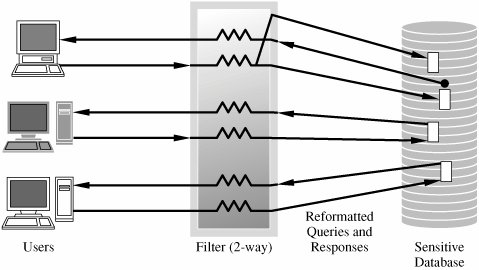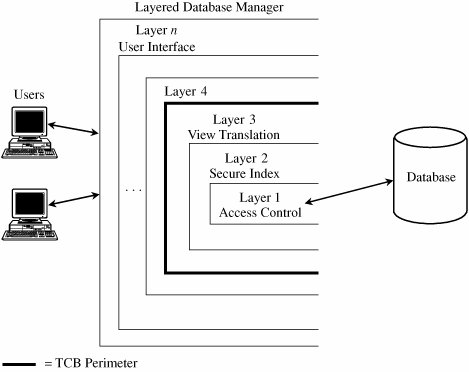Section 6.7. Proposals for Multilevel Security
6.7. Proposals for Multilevel SecurityAs you can already tell, implementing multilevel security for databases is difficult, probably more so than in operating systems, because of the small granularity of the items being controlled. In the remainder of this section, we study approaches to multilevel security for databases. SeparationAs we have already seen, separation is necessary to limit access. In this section, we study mechanisms to implement separation in databases. Then, we see how these mechanisms can help to implement multilevel security for databases. PartitioningThe obvious control for multilevel databases is partitioning. The database is divided into separate databases, each at its own level of sensitivity. This approach is similar to maintaining separate files in separate file cabinets. This control destroys a basic advantage of databases: elimination of redundancy and improved accuracy through having only one field to update. Furthermore, it does not address the problem of a high-level user who needs access to some low-level data combined with high-level data. Nevertheless, because of the difficulty of establishing, maintaining, and using multilevel databases, many users with data of mixed sensitivities handle their data by using separate, isolated databases. EncryptionIf sensitive data are encrypted, a user who accidentally receives them cannot interpret the data. Thus, each level of sensitive data can be stored in a table encrypted under a key unique to the level of sensitivity. But encryption has certain disadvantages. First, a user can mount a chosen plaintext attack. Suppose party affiliation of REP or DEM is stored in encrypted form in each record. A user who achieves access to these encrypted fields can easily decrypt them by creating a new record with party=DEM and comparing the resulting encrypted version to that element in all other records. Worse, if authentication data are encrypted, the malicious user can substitute the encrypted form of his or her own data for that of any other user. Not only does this provide access for the malicious user, but it also excludes the legitimate user whose authentication data have been changed to that of the malicious user. These possibilities are shown in Figures 6-5 and 6-6. Figure 6-5. Cryptographic Separation: Different Encryption Keys. Figure 6-6. Cryptographic Separation: Block Chaining. Using a different encryption key for each record overcomes these defects. Each record's fields can be encrypted with a different key, or all fields of a record can be cryptographically linked, as with cipher block chaining. The disadvantage, then, is that each field must be decrypted when users perform standard database operations such as "select all records with SALARY > 10,000." Decrypting the SALARY field, even on rejected records, increases the time to process a query. (Consider the query that selects just one record but that must decrypt and compare one field of each record to find the one that satisfies the query.) Thus, encryption is not often used to implement separation in databases. Integrity LockThe integrity lock was first proposed at the U.S. Air Force Summer Study on Data Base Security [AFS83]. The lock is a way to provide both integrity and limited access for a database. The operation was nicknamed "spray paint" because each element is figuratively painted with a color that denotes its sensitivity. The coloring is maintained with the element, not in a master database table. A model of the basic integrity lock is shown in Figure 6-7. As illustrated, each apparent data item consists of three pieces: the actual data item itself, a sensitivity label, and a checksum. The sensitivity label defines the sensitivity of the data, and the checksum is computed across both data and sensitivity label to prevent unauthorized modification of the data item or its label. The actual data item is stored in plaintext, for efficiency because the DBMS may need to examine many fields when selecting records to match a query. Figure 6-7. Integrity Lock. The sensitivity label should be
The third piece of the integrity lock for a field is an error-detecting code, called a cryptographic checksum. To guarantee that a data value or its sensitivity classification has not been changed, this checksum must be unique for a given element, and must contain both the element's data value and something to tie that value to a particular position in the database. As shown in Figure 6-8, an appropriate cryptographic checksum includes something unique to the record (the record number), something unique to this data field within the record (the field attribute name), the value of this element, and the sensitivity classification of the element. These four components guard against anyone's changing, copying, or moving the data. The checksum can be computed with a strong encryption algorithm or hash function. Figure 6-8. Cryptographic Checksum. Sensitivity LockThe sensitivity lock shown in Figure 6-9 was designed by Graubert and Kramer [GRA84b] to meet these principles. A sensitivity lock is a combination of a unique identifier (such as the record number) and the sensitivity level. Because the identifier is unique, each lock relates to one particular record. Many different elements will have the same sensitivity level. A malicious subject should not be able to identify two elements having identical sensitivity levels or identical data values just by looking at the sensitivity level portion of the lock. Because of the encryption, the lock's contents, especially the sensitivity level, are concealed from plain view. Thus, the lock is associated with one specific record, and it protects the secrecy of the sensitivity level of that record. Figure 6-9. Sensitivity Lock. Designs of Multilevel Secure DatabasesThis section covers different designs for multilevel secure databases. These designs show the tradeoffs among efficiency, flexibility, simplicity, and trustworthiness. Integrity LockThe integrity lock DBMS was invented as a short-term solution to the security problem for multilevel databases. The intention was to be able to use any (untrusted) database manager with a trusted procedure that handles access control. The sensitive data were obliterated or concealed with encryption that protected both a data item and its sensitivity. In this way, only the access procedure would need to be trusted because only it would be able to achieve or grant access to sensitive data. The structure of such a system is shown in Figure 6-10. Figure 6-10. Trusted Database Manager. The efficiency of integrity locks is a serious drawback. The space needed for storing an element must be expanded to contain the sensitivity label. Because there are several pieces in the label and one label for every element, the space required is significant. Problematic, too, is the processing time efficiency of an integrity lock. The sensitivity label must be decoded every time a data element is passed to the user to verify that the user's access is allowable. Also, each time a value is written or modified, the label must be recomputed. Thus, substantial processing time is consumed. If the database file can be sufficiently protected, the data values of the individual elements can be left in plaintext. That approach benefits select and project queries across sensitive fields because an element need not be decrypted just to determine whether it should be selected. A final difficulty with this approach is that the untrusted database manager sees all data, so it is subject to Trojan horse attacks by which data can be leaked through covert channels. Trusted Front EndThe model of a trusted front-end process is shown in Figure 6-11. A trusted front end is also known as a guard and operates much like the reference monitor of Chapter 5. This approach, originated by Hinke and Schaefer [HIN75], recognizes that many DBMSs have been built and put into use without consideration of multilevel security. Staff members are already trained in using these DBMSs, and they may in fact use them frequently. The front-end concept takes advantage of existing tools and expertise, enhancing the security of these existing systems with minimal change to the system. The interaction between a user, a trusted front end, and a DBMS involves the following steps. Figure 6-11. Trusted Front End.
The trusted front end serves as a one-way filter, screening out results the user should not be able to access. But the scheme is inefficient because potentially much data is retrieved and then discarded as inappropriate for the user. Commutative FiltersThe notion of a commutative filter was proposed by Denning [DEN85] as a simplification of the trusted interface to the DBMS. Essentially, the filter screens the user's request, reformatting it if necessary, so that only data of an appropriate sensitivity level are returned to the user. A commutative filter is a process that forms an interface between the user and a DBMS. However, unlike the trusted front end, the filter tries to capitalize on the efficiency of most DBMSs. The filter reformats the query so that the database manager does as much of the work as possible, screening out many unacceptable records. The filter then provides a second screening to select only data to which the user has access. Filters can be used for security at the record, attribute, or element level.
Suppose a group of physicists in Washington works on very sensitive projects, so the current user should not be allowed to access the physicists' names in the database. This restriction presents a problem with this query: retrieve NAME where ((OCCUP=PHYSICIST) Suppose, too, that the current user is prohibited from knowing anything about any people in Moscow. Using a conventional DBMS, the query might access all records, and the DBMS would then pass the results on to the user. However, as we have seen, the user might be able to infer things about Moscow employees or Washington physicists working on secret projects without even accessing those fields directly. The commutative filter re-forms the original query in a trustable way so that sensitive information is never extracted from the database. Our sample query would become retrieve NAME where ((OCCUP=PHYSICIST) The filter works by restricting the query to the DBMS and then restricting the results before they are returned to the user. In this instance, the filter would request NAME, NAME-SECRECY-LEVEL, OCCUP, OCCUP-SECRECY-LEVEL, CITY, and CITY-SECRECY-LEVEL values and would then filter and return to the user only those fields and items that are of a secrecy level acceptable for the user. Although even this simple query becomes complicated because of the added terms, these terms are all added by the front-end filter, invisible to the user. An example of this query filtering in operation is shown in Figure 6-12. The advantage of the commutative filter is that it allows query selection, some optimization, and some subquery handling to be done by the DBMS. This delegation of duties keeps the size of the security filter small, reduces redundancy between it and the DBMS, and improves the overall efficiency of the system. Figure 6-12. Commutative Filters. Distributed DatabasesThe distributed or federated database is a fourth design for a secure multilevel database. In this case, a trusted front end controls access to two unmodified commercial DBMSs: one for all low-sensitivity data and one for all high-sensitivity data. The front end takes a user's query and formulates single-level queries to the databases as appropriate. For a user cleared for high-sensitivity data, the front end submits queries to both the high- and low-sensitivity databases. But if the user is not cleared for high-sensitivity data, the front end submits a query to only the low-sensitivity database. If the result is obtained from either back-end database alone, the front end passes the result back to the user. If the result comes from both databases, the front end has to combine the results appropriately. For example, if the query is a join query having some high-sensitivity terms and some low, the front end has to perform the equivalent of a database join itself. The distributed database design is not popular because the front end, which must be trusted, is complex, potentially including most of the functionality of a full DBMS itself. In addition, the design does not scale well to many degrees of sensitivity; each sensitivity level of data must be maintained in its own separate database. Window/ViewTraditionally, one of the advantages of using a DBMS for multiple users of different interests (but not necessarily different sensitivity levels) is the ability to create a different view for each user. That is, each user is restricted to a picture of the data reflecting only what the user needs to see. For example, the registrar may see only the class assignments and grades of each student at a university, not needing to see extracurricular activities or medical records. The university health clinic, on the other hand, needs medical records and drug-use information but not scores on standardized academic tests. The notion of a window or a view can also be an organizing principle for multilevel database access. A window is a subset of a database, containing exactly the information that a user is entitled to access. Denning [DEN87a] surveys the development of views for multilevel database security. A view can represent a single user's subset database so that all of a user's queries access only that database. This subset guarantees that the user does not access values outside the permitted ones, because nonpermitted values are not even in the user's database. The view is specified as a set of relations in the database, so the data in the view subset change as data change in the database. For example, a travel agent might have access to part of an airline's flight information database. Records for cargo flights would be excluded, as would the pilot's name and the serial number of the plane for every flight. Suppose the database contained an attribute TYPE whose value was either CARGO or PASS (for passenger). Other attributes might be flight number, origin, destination, departure time, arrival time, capacity, pilot, and tail number. Now suppose the airline created some passenger flights with lower fares that could be booked only directly through the airline. The airline might assign their flight numbers a more sensitive rating to make these flights unavailable to travel agents. The whole database, and the agent's view, might have the logical structure shown in Table 6-18.
The travel agent's view of the database is expressed as view AGENT-INFO FLTNO:=MASTER.FLTNO ORIG:=MASTER.ORIG DEST:=MASTER.DEST DEP:=MASTER.DEP ARR:=MASTER.ARR CAP:=MASTER.CAP where MASTER.TYPE='PASS' class AGENT auth retrieve Because the access class of this view is AGENT, more sensitive flight numbers (flights booked only through the airline) do not appear in this view. Alternatively, we could have eliminated the entire records for those flights by restricting the record selection with a where clause. A view may involve computation or complex selection criteria to specify subset data. The data presented to a user is obtained by filtering of the contents of the original database. Attributes, records, and elements are stripped away so that the user sees only acceptable items. Any attribute (column) is withheld unless the user is authorized to access at least one element. Any record (row) is withheld unless the user is authorized to access at least one element. Then, for all elements that still remain, if the user is not authorized to access the element, it is replaced by UNDEFINED. This last step does not compromise any data because the user knows the existence of the attribute (there is at least one element that the user can access) and the user knows the existence of the record (again, at least one accessible element exists in the record). In addition to elements, a view includes relations on attributes. Furthermore, a user can create new relations from new and existing attributes and elements. These new relations are accessible to other users, subject to the standard access rights. A user can operate on the subset database defined in a view only as allowed by the operations authorized in the view. As an example, a user might be allowed to retrieve records specified in one view or to retrieve and update records as specified in another view. For instance, the airline in our example may restrict travel agents to retrieving data. The Sea Views project described in [DEN87a, LUN90a] is the basis for a system that integrates a trusted operating system to form a trusted database manager. The layered implementation as described is shown in Figure 6-13. The lowest layer, the reference monitor, performs file interaction, enforcing the BellLa Padula access controls, and does user authentication. Part of its function is to filter data passed to higher levels. The second level performs basic indexing and computation functions of the database. The third level translates views into the base relations of the database. These three layers make up the trusted computing base (TCB) of the system. The remaining layers implement normal DBMS functions and the user interface. Figure 6-13. Secure Database Decomposition. This layered approach makes views both a logical division of a database and a functional one. The approach is an important step toward the design and implementation of a trustable database management system. Practical IssuesThe multilevel security problem for databases has been studied since the 1970s. Several promising research results have been identified, as we have seen in this chapter. However, as with trusted operating systems, the consumer demand has not been sufficient to support many products. Civilian users have not liked the inflexibility of the military multilevel security model, and there have been too few military users. Consequently, multilevel secure databases are primarily of research and historical interest. The general concepts of multilevel databases are important. We do need to be able to separate data according to their degree of sensitivity. Similarly, we need ways of combining data of different sensitivities into one database (or at least into one virtual database or federation of databases). And these needs will only increase over time as larger databases contain more sensitive information, especially for privacy concerns. In the next section we study data mining, a technique of growing significance, but one for which we need to be able to address degrees of sensitivity of the data. | ||||||||||||||||||||||||||||||||||||||||||||||||||||||||||||||||||||||||||||||||||||||||||||||||||||||||||||||||||||||||||||||||||||||||||||||||||||||||||||||||||||||||||||||||||||||
EAN: 2147483647
Pages: 171
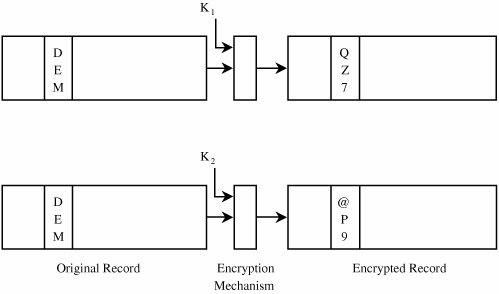



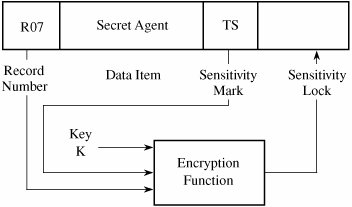

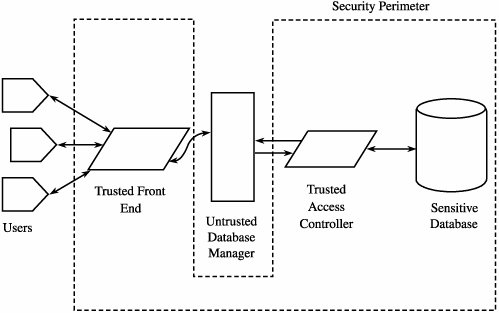
 (CITY=WASHDC))
(CITY=WASHDC))  USER-SECRECY-LEVEL)
USER-SECRECY-LEVEL) 